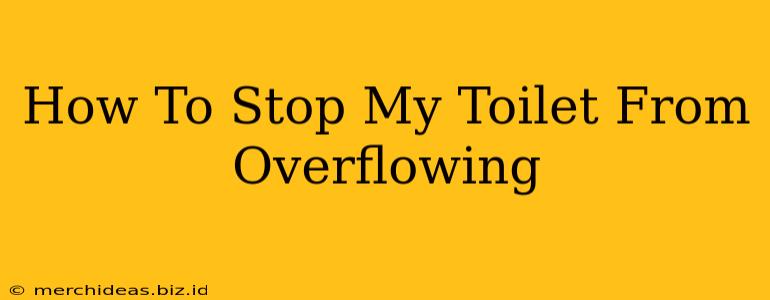A toilet overflowing is a plumbing emergency that nobody wants to face. The sight of water gushing over the bowl's rim is enough to send shivers down anyone's spine. But before you panic and call a plumber (though that might be necessary eventually!), there are several steps you can take to stop the overflow and prevent further damage. This guide will walk you through how to stop your toilet from overflowing and provide preventative measures for the future.
Understanding the Causes of Toilet Overflow
Before tackling the solution, it's crucial to understand why your toilet is overflowing. This will help you address the underlying issue and prevent future occurrences. Common causes include:
- Clogged Toilet: This is the most frequent culprit. Too much toilet paper, feminine hygiene products, or other non-flushable items can cause a blockage.
- Faulty Flapper: The flapper is a rubber seal that controls water flow into the bowl. If it's damaged or worn out, it can allow water to continuously flow into the bowl, leading to an overflow.
- Problems with the Fill Valve: The fill valve is responsible for refilling the tank after each flush. A malfunctioning fill valve might continuously fill the tank, eventually causing an overflow.
- Low Water Level: A consistently low water level in the tank can lead to incomplete flushes, causing clogs and potential overflows. This often indicates a problem with the fill valve.
- Severe Clog in the Drain: A clog further down the drain line, beyond the toilet itself, can back up and cause an overflow. This usually involves more significant plumbing issues.
How to Stop an Overflowing Toilet – Immediate Actions
1. Turn Off the Water Supply: This is the most crucial first step. Locate the shut-off valve behind the toilet (usually a small handle or knob). Turn it clockwise to stop the water flow into the tank. This prevents further water from entering the bowl and worsening the situation.
2. Remove Excess Water: Carefully use a bucket, plunger, sponge, or towels to remove as much excess water from the bowl as possible. This will give you more room to work and prevent further spillage.
3. Plunge the Toilet (If Applicable): If the overflow is due to a simple clog, use a plunger to try and clear the blockage. Make sure to create a good seal around the plunger and push and pull vigorously.
4. Try a Toilet Auger (If Plunging Fails): If plunging doesn't work, a toilet auger (also known as a closet auger) might be necessary. This flexible tool can reach further down the drain to break up or retrieve the clog. Follow the instructions carefully and consider wearing protective gloves.
5. Assess the Situation: Once the immediate overflow has stopped, carefully examine the toilet to determine the root cause. Is there a visible clog? Is the flapper leaking? Is the water level in the tank consistently low?
Preventing Future Toilet Overflows: Proactive Steps
- Avoid Flushing Non-Flushable Items: This includes feminine hygiene products, cotton swabs, diapers, and wipes. Only flush toilet paper and human waste.
- Regularly Check the Flapper: Inspect the flapper for wear and tear. A slightly cracked or warped flapper can lead to constant leaking. Replace it if necessary.
- Check the Fill Valve: Ensure the fill valve is functioning correctly. A malfunctioning fill valve should be replaced.
- Maintain Proper Water Level: The water level in the tank should be at the appropriate level – usually indicated by a fill line inside the tank. If the water level is consistently low, investigate the fill valve.
- Periodically Clean the Toilet: Regularly cleaning your toilet can prevent clogs from building up and ensures smooth operation.
- Consider a Plunger Upgrade: Invest in a good-quality plunger specifically designed for toilets. A better seal will increase efficiency.
When to Call a Plumber
If you've tried the above steps and your toilet is still overflowing, or if you suspect a more serious plumbing issue (like a drain clog), it's best to call a professional plumber. Ignoring a plumbing problem can lead to significant water damage and expensive repairs.
By understanding the causes of toilet overflows and taking the appropriate steps, you can effectively handle this common plumbing issue and maintain a smoothly functioning toilet system. Remember, prevention is key!
